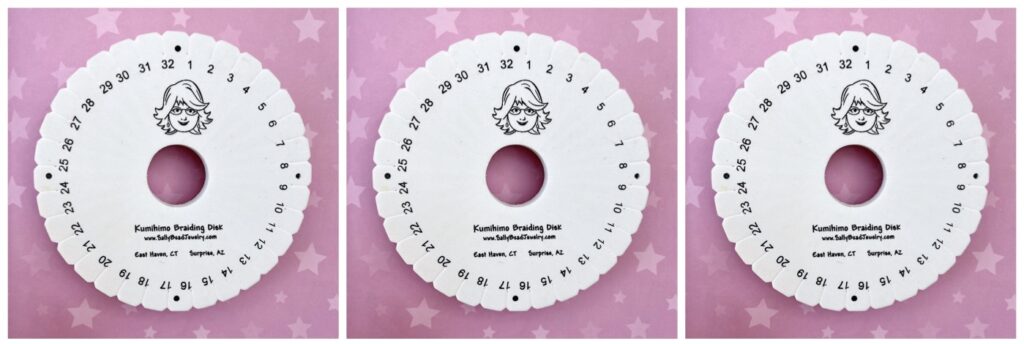What is so good about the SallyBeadJewelry kumihimo disk? In this blog I would like to tell you about the kumihimo disk designed by Sally Battis some years ago and to explain what its best features are. As far as I am aware, Sally was the first person to produce a double thickness kumihimo disk. When the first foam disk was designed by Makiko Tada the majority of kumihimo was textile based, but once the jewellery making world became aware of the possibilities for adding beads to kumihimo using this accessible and low-cost tool there was an explosion of creativity. It was no longer necessary to invest in the complex and costly marudai because a simple foam disk could be used to make a wide range of beaded braids. The process of balancing weighted bobbins with the counterweight was no longer necessary because the simple slots cut into the disk could anchor the braid just as well. However, for the slots on a disk to work effectively they need to be able to grip the cords and this ability is decreased when the slots are stretched through the use of wide cords. When the cords slip in the slots the braid becomes loose and it is more difficult to tuck the bead into the correct position and keep it there. For this reason, it is advisable to use one disk for thicker cords and to reserve your newest disk for your thinner beading cord required for most beaded braids. This works well for most braiders, but gradually even your reserved disk will start to lose its ability to grip the cords firmly.
Sally’s disk is twice the thickness of a regular kumihimo disk and this extra depth allows the slots to grip even the finest cords very firmly. It is also far more durable than the regular disk. I have several of these disks and although very slight stretching of the slots has occured over time I am still able to use my very first one for beaded braids.
The SallyBeadJewelry disk has a unique feature that is a shallow well around the hole carved out on the underside. This makes it much more comfortable to grip for most people than other types of extra-thick/double density disk. Most people seem to hold their disk with their thumb on top and the fingers underneath. If you have average-sized hands you will find that the tips of your fingers can curl up very comfortably into the well. Some people do not hold the disk at all, but grip the braid close to the disk from underneath. In this case the well allows more room for your fingers.
The other difference is in the location of the numbers on the disk. On Makiko Tada’s original disk the slot numbers are printed in between the numbers. The number is printed on the left of its slot, when the number is viewed the correct way up. This can create confusion when you are following a pattern using the numbers. On Sally’s disk the numbers are printed directly below the slots, so there can be no misunderstandings.
An additional benefit is the ability to use a template for the 7 cord braid. This is placed on top of the disk and held in place by the cords. The lettering and slots guide the braider through the moves of the 7 cord braid and the template can be placed over different slots to even out the wear on the slots.
What about the downsides of the disk? The only thing I don’t like is the spelling of the word ‘jewelry’ because I am English and I know that the only correct spelling is ‘jewellery’! I guess I can live with that because the disk is a really great tool!
Unfortunately, recent changes to tax requirements to products imported to the UK mean that many smaller businesses are unwilling to sell retail to UK customers, so for the last couple of years it has not been possible for us to buy the SallyBeadJewelry disk. However, I have managed to secure a limited number of disks for sale in the UK and they can be found in the shop on my website. When they are gone they are gone! If you reside outside of the UK you will be able to purchase from Sally Battis directly, at sallybeadjewelry.com

